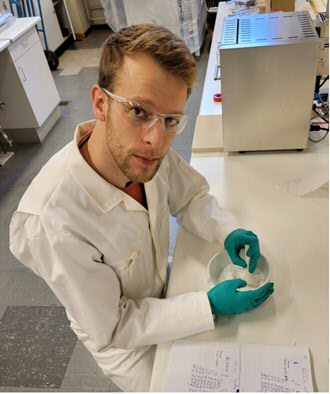Advent calendar - December 16th - Siebe van der Veer
In the Zernike Institute Advent Calendar, we are presenting 24 short spotlights in December. In these specials, we highlight PhD students, postdocs, support staff, and technicians of our research groups and team - providing a glimpse in their typical day at work. In Episode 16 meet Siebe van der Veer, part-time researcher at Kisuma Chemicals in Veendam and part-time PhD student in the group of Graeme Blake.

My name is Siebe van der Veer, part-time researcher at Kisuma Chemicals in Veendam since 2012 and part-time PhD student in the group of Graeme Blake since 2021.
At Kisuma we produce minerals, i.e. Magnesium Hydroxide and Hydrotalcite-like materials, that are mostly used as additives in the polymer industry. For example, to most polypropylene a few hundred ppm of the Hydrotalcite produced by our mother company in Japan and us in Veendam are added for downstream corrosion protection against acid residues from catalysts. Another nice example of the high-end application of our products is that of our Magnesium hydroxide that is used as a flame retardant in (electric) wires and cables and can comprise up to 70 volume % of the formulation. Our largest product family, however, are the Hydrotalcites as heat stabilizers in PVC.
Although our products are mostly used in polymers at the moment, our core focus is on Magnesium products. This focus gave rise to the mission of the R&D department, which I was the first member of in June of 2012, which was to develop Magnesium based materials for new and existing markets. A lot of different applications for Hydrotalcite have been explored over the years, but the topic I am exclusively involved in these days, both at Kisuma and here at the university, is that of a Potassium, Magnesium and Aluminium-based CO2 sorbent.
This sorbent is used as the active material in the sorption-enhanced water-gas-shift (SEWGS) technology that has been developed by TNO in Petten. The technology is used to achieve reactive separation of CO2 and H2 from residual gases in industry (e.g. from steel production) in order to decarbonize these industries that are vital to society. Together with our partners we aim to bring this technology to the market before the end of the decade.
A lot of studies have been done on this SEWGS technology and on the functionality of the sorbent, but much is still unknown. During my Ph.D. I hope to shed some light on what local structures there exist in this sorbent material and which serve what function during the adsorption process of CO2 and the other components in industrial syngases. For this we are hoping to employ techniques such as SSNMR, EXAFS, HRTEM, 2D-IR spectroscopy, and others to find our answers both ex-situ and in-situ.
Contact: Siebe van der Veer
More news
-
15 September 2025
Successful visit to the UG by Rector of Institut Teknologi Bandung
